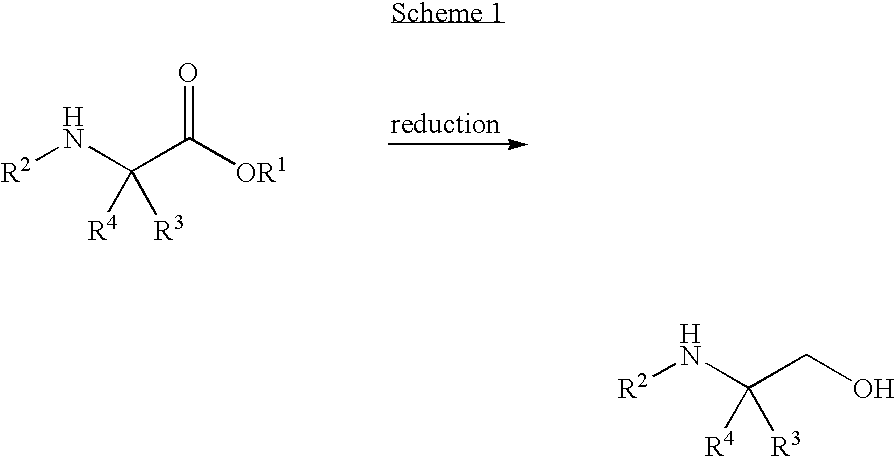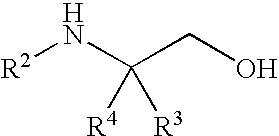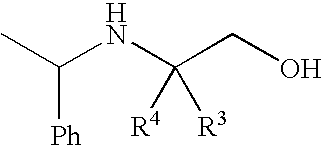Methods for preparing sulfonamide substituted alcohols and intermediates thereof
a technology of sulfonamide and substitute alcohol, which is applied in the preparation of amino compounds, oxygen-containing compound preparations, drug compositions, etc., can solve the problem that the accumulation of beta amyloid is toxic to neurons in cell cultur
- Summary
- Abstract
- Description
- Claims
- Application Information
AI Technical Summary
Benefits of technology
Problems solved by technology
Method used
Image
Examples
example 1
Preparation of 4,4,4-Trifluoro-2-(1-Phenethylamino)-3-Trifluoromethylbutan-1 -ol
[0089]A solution of 50% NaOH (24 g, 0.302 mol) in water (80 mL) was added to a suspension of ethyl 4,4,4,4′,4′,4′-hexafluoro-N-[(1R)-1-phenylethyl]-L-valinate hydrochloride salt aminoester (100 g, 0.254 mol) in water (278 mL) and toluene (1.01 L). The mixture was stirred for 30 minutes and then the two phases were separated. The toluene layer was washed with water (2×195 mL) and the water was removed by azeotroping. The toluene solution was distilled under atmospheric pressure until the vapor temperature reached about 108-110° C., whereby about 600 mL of toluene remained in the flask.
[0090]A solution of DIBAL-H in toluene (1.5 N, 518 mL, 0.78 mol) was cooled to −10° C. and then the aminoester toluene solution (about 600 mL) was added over about 90 minutes while keeping the reaction mixture at about −8 to −11° C. The mixture was then stirred for about 10 minutes. EtOH (29 mL, 0.5 mol) was then added over ...
example 2
Preparation of 5-Chloro-N-[(1S)-3,3,3-trifluoro-1-(hydroxymethyl)-2-(trifluoro-methyl)propyl]thiophene-2-sulfonamide
[0092]4-methyl morpholine (2.7 mL, 24.6 mmol) was added to a suspension of (2S)-2-amino-4,4,4-tri-fluoro-3-(trifluoromethyl)butan-1-ol (2 g, 8.1 mmol) in isopropyl acetate (10 mL). The mixture was stirred at about 20-25° C. for about 5-10 minutes and then 5-chlorothiophene-2-sulfonyl chloride (2.0 g, 9.2 mmol) was added. The reaction mixture was stirred at 20-25° C. for 6-18 hours. Water (10 mL) was then added to the reaction mixture, whereby the solids dissolved. The two layers were then separated and the organic layer was washed with a solution of 10% NaHCO3 (10 mL) and 10% NaCl (10 mL). Heptane (10 mL) was added to the isopropyl acetate layer (about 10 mL). The mixture was then distilled down to about half of its original volume under atmospheric distillation. While the solution remained at about 80-90° C., heptane (10 mL) was added over 5-10 minutes, during which t...
PUM
| Property | Measurement | Unit |
|---|---|---|
| Temperature | aaaaa | aaaaa |
| Temperature | aaaaa | aaaaa |
| Temperature | aaaaa | aaaaa |
Abstract
Description
Claims
Application Information
 Login to View More
Login to View More - R&D Engineer
- R&D Manager
- IP Professional
- Industry Leading Data Capabilities
- Powerful AI technology
- Patent DNA Extraction
Browse by: Latest US Patents, China's latest patents, Technical Efficacy Thesaurus, Application Domain, Technology Topic, Popular Technical Reports.
© 2024 PatSnap. All rights reserved.Legal|Privacy policy|Modern Slavery Act Transparency Statement|Sitemap|About US| Contact US: help@patsnap.com










